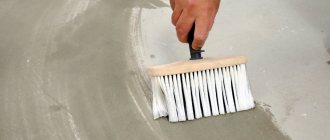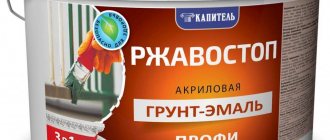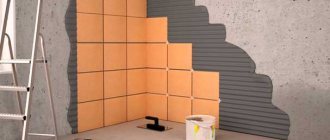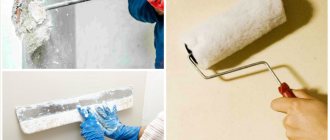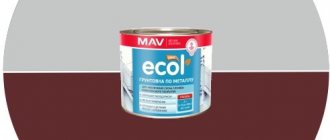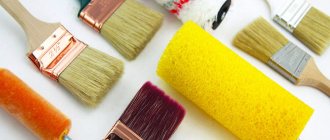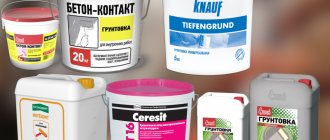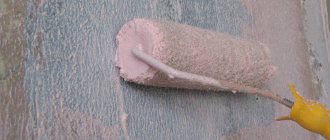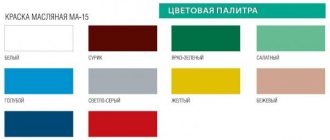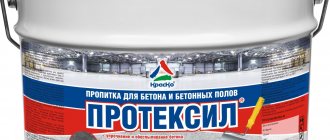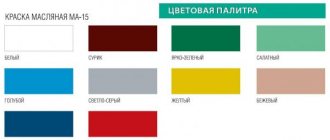Priming external metal surfaces is a mandatory stage in their preparation for subsequent decorative finishing. If the process of selecting and applying the emulsion composition is carried out correctly, the product will be protected from rust and corrosion for many years. It is important for us, ordinary buyers of many types of building materials, to understand that a primer for metal is the base necessary for its better adhesion to paint, enamel, and varnish. The final appearance and durability of the processed material largely depends on it. Every buyer who wants to choose a high-quality primer for metal for painting must take into account the differences in existing types of mixtures and the features of their application.
Priming metal before painting – why primer?
Each metal primer contains special substances - inhibitors. They protect metals from their inherent self-destruction through corrosion. In addition to their protective properties, primers are used to ensure the best adhesion between the surface to be painted and the paint composition, which is especially important for zinc and aluminum.
For aluminum, zinc-based primers or urethane paint are best suited. It is optimal to treat steel with a primer containing zinc phosphates or its metal powder. Copper, bronze and brass are usually not painted, but coated with epoxy or polyurethane varnish if necessary.
Photo of anti-rust primer for car xn--2111-43da1a8c.xn--p1ai
In the photo - Hamerton anti-corrosion primer, stroyboard.su
Photo of acrylic primer for metal, xn--b1agsv4c.xn--p1ai
In the photo - anti-rust aerosol for metal, ogodom.ru
Photo of anti-corrosion enamel for rust, my-shop-stroy.ru
Features of choice
First of all, anti-corrosion mixtures are selected based on the type and condition of the metal that needs to be treated. The main purpose of a primer when coating ferrous metals is to slow down corrosion. Iron, cast iron, black steel and alloys based on them used for outdoor work are very susceptible to corrosion due to interaction with a merciless environment. For these materials, if they have already begun to rust, a converter should be used as a priority. It will at least partially eliminate traces of corrosion. If the primer mixture is selected for external products made of non-ferrous metal or alloy, for example zinc, copper, brass, aluminum, then its primary function is to ensure maximum adhesion between the treated surface and other finishing material. For this purpose, you can choose compositions based on organic solvents, with a urethane base, and containing zinc. They can be used as a protective coating for galvanized iron or steel. Bronze, brass and copper are best protected with polyurethane or epoxy varnish. On sale you can find types of primers for metal that are applied to hide difficult to remove stains, for example, from grease, soot, etc. This step in the repair cannot be skipped if you do not want the stains to reappear over time or provoke peeling of the decorative finishing. After choosing a primer, you can begin to study the instructions for its external use.
IMPORTANT: 1. pay attention not only to the properties and types of primer, but also to the form of its release. To dilute powder bases and concentrates, it may be necessary to purchase a special solvent; 2. check the compatibility of the selected primer mixture with the planned decorative coating - they may be incompatible.
How to choose a primer for metal and how to apply it?
There are several factors to consider when choosing a primer:
- what metal is processed;
- under what conditions it will be used (environmental aggressiveness, climatic conditions, mechanical loads);
- the type of substance that forms the film.
After choosing a primer, you can begin surface treatment. The first thing to do is check the existing paint layer. To do this, make two cuts, stick tape between them and sharply tear it off. If the paint comes off, it will have to be removed completely.
Next, you need to clean the surface from rust and other contaminants. After these procedures, you can begin to apply a thin layer of primer. Do this using a roller, brush and paint sprayer.
If the surface turns out to be glossy, then you need to clean it with fine-grained sandpaper for better adhesion to the paint. And only now can you begin to apply a layer of paint.
Choosing the right soil mixture
When purchasing a primer, there are several key factors to consider:
Taking into account all these parameters, it is possible to select the ideal composition for a specific type of work. Each type of metal has its own types of primer. There are compositions for cast iron, galvanized, non-ferrous alloys, steel and iron.
Be sure to take into account the tool that will be used for application. If a spray gun is used, the composition must be liquid. If you use the powder version of the primer mixture, then it must be diluted strictly according to the instructions.
When applied with a roller, any form of release of the mixture is perfect. When applied correctly, this is an economical method in terms of material consumption.
Use a brush to treat small areas and hard-to-reach surfaces.
Compositions in aerosol cans are more expensive.
No. 2. Types of primers for walls by composition
Depending on the characteristics of the composition, the following main types of primers :
- acrylic primer is the most versatile composition that can be used to coat wood, concrete, chipboard, brick, old and new plaster. Acrylic primer can be used to treat porous substrates, is odorless, dries quickly (about 5 hours), and forms a “breathable” surface. The only negative is that it is not suitable for priming metal surfaces;
- alkyd primer is an ideal option for treating wooden surfaces , which under the influence of such a primer acquire a slightly swollen structure, which ensures excellent adhesion to any finishing materials : from wallpaper and painting to cement-sand coatings. One layer of this primer takes about 15 hours to dry. Substances that prevent the development of corrosion and mold may be added to the composition;
- glypthal primer is one of the few compounds that can be used to treat metal surfaces . It is also sometimes used on wooden walls. The primer dries within 24 hours, but has a limitation - it is only suitable for relatively dry rooms, since it loses its properties with constant exposure to high humidity;
- perchlorovinyl primer is a universal composition that can be used to process wood, brick, plaster and even metal. It dries quickly, and in summer at high temperatures one layer dries in 1 hour. This primer is not used inside residential premises due to its toxicity, but it may be suitable for external work
- polyvinyl acetate primer consists of polyvinyl acetate dispersion and latex, can be applied to any surface and is used only as a base for polyvinyl acetate paint . Dries quickly, up to 30 minutes;
- Phenolic primer is used as the first layer when processing metal and wooden structures. The composition dries up to 15 hours, is used for outdoor work only;
- polystyrene primer also cannot be used for interior work; plastered and wooden surfaces are treated with it;
- aluminum plasters , as a rule, are used to treat wooden surfaces and can additionally protect them from fungal attack;
- Epoxy primers are suitable for metal and concrete. They protect metal from corrosion, and allow concrete to better adhere to the finish;
- shellac primers are used to treat wooden surfaces and prevent the release of resins;
- mineral primers are produced on the basis of gypsum, lime and cement, and are used to treat the surface of concrete and brick walls. Such soil dries from 3 to 24 hours, which depends on the thickness of the layer and the nature of the surface material.
We recommend: Decor and durability - is it necessary to install corners for tiles
universal primers on sale . The very name of these compositions suggests that they can be used for application to any surface. They are used to carry out minor construction and repair work, when the required composition with specific qualities is not at hand, and also sometimes for treating surfaces consisting of different materials.
Features of choosing soil for a fence
The primer will not only ensure an even and economical application of the decorative paint coating on the base, but also, if chosen correctly, will ensure a long service life of the fence and its presentable appearance. The choice of primer mixture depends on the characteristics of the material and its structure:
- Fence made of corrugated board. Beautiful, durable, easy to care for. In this case, only the pillars and load-bearing parts require additional processing. The profiled sheets themselves are coated with polymer decorative paint, which guarantees a long service life. After a few years, the coating may lose its original appearance, then the corrugated sheeting can be painted.
- A fence made using metal sheets. In this case, the pillars and surfaces are completely primed before painting. It is imperative to use mixtures with an anti-corrosion coating - they will provide reliable protection against corrosion and rust. By clicking on the link you can learn about the features of painting metal fences.
- Wooden picket fence is a natural, durable and beautiful material, but it requires special protection. Wood surfaces are primed with compounds containing antiseptics that protect against moisture, mildew and mold. Additionally, you can apply fire retardant impregnation, ensuring fireproof properties.
- Concrete fences are one of the most durable and popular. They are quickly erected, the material is inexpensive, but the porous structure of concrete easily absorbs water, is destroyed by atmospheric agents, and the gray color looks boring. Correctly executed priming and subsequent painting of a concrete fence can extend its life and turn it into a decorative element. Mineral-based soils are best suited for concrete - they fill the porous structure of the base well, significantly reduce the ability to absorb moisture, and ensure uniform application of the finishing coating.
- Brick fences, due to the variety of structure and color, are beautiful in themselves. They do not require additional decorative painting. But brick has strong moisture-absorbing properties and can quickly collapse under the influence of precipitation. For its long service life, it is better to use transparent primers that do not require subsequent application of paint.
Fence posts can be wooden or metal. For wooden posts, the same soil is used as for the main part of the fence, while metal posts require additional anti-corrosion protection.
For mixed surfaces, you can use universal compounds suitable for different types of material. Before processing, metal poles must be coated with an additional anti-corrosion coating to protect against rust.
Passivating primer for metal
It can reduce electrochemical characteristics. Helps slow down corrosion. If we talk about the inhibitory mixture, then it forms on the surface a new type of material similar to enamel primer, which combines the properties of two compositions. The inhibitors that are included in its composition can be aqueous or oil-soluble.
3
Application Tools
When choosing a primer for metal, it is advisable to take into account the tool with which priming will be carried out. For a spray gun, liquid mixtures are considered optimal; in this case, you should purchase formulations in powder form or concentrates. They are easily diluted using solvent or water. The spray gun is indispensable when processing large surfaces.
When working with water-dispersed compositions, you should remember their quick-drying properties; it is recommended to apply the next layer immediately after the previous one has dried.
Roller priming involves using any type of compound due to its ability to provide even distribution. It is not advisable to use a brush as an independent tool, since the consumption of soil will be too large. It is only good for processing areas with difficult access.
The manufacturer produces metal primer not only in special cans, but also in aerosol cans. This option is convenient to use, but its capacity is small, so for priming large structures or metal sheets you will need a large number of them.
Before applying the composition, it is necessary to clean the surface from rust stains and dirt, and then degrease it.
1.2
Types of material
There are several types of primer designed for working with metal surfaces. Each of them corresponds to certain factors, such as the type of metal being processed (non-ferrous or ferrous), the degree of load on it, and the features of the finishing coating that will be applied on top.
No less important are the conditions in which the product undergoing priming will be located: indoors or outdoors. With a wide range of such compositions, it is quite difficult to make the right choice, so it is recommended that you first familiarize yourself with all of their types.
Phosphating
The production of these compositions is based on the use of two main components: solvents and an inorganic compound (orthophosphoric acid). These primers are universal types that can be applied to all metal surfaces. But in order for the result to be much more productive, it is advisable to process products that have not been subject to corrosion.
Phosphating primers have excellent adhesion, which results in the formation of a porous layer. A surface prepared in this way is ideal for applying any paintwork on metal. Typically, such compositions are used when working with steel; in rare cases, they are used for galvanizing and aluminum.
Varnishes and paints made on bases such as alkyd, epoxy, ethanol and polyurethane are well suited to this primer. The applied layer is highly resistant to heat. Such a coating can withstand temperatures that range from one hundred and fifty to two hundred and twenty degrees.
The disadvantage of phosphating primer is expressed in weak protection against corrosion, to ensure which it is necessary to combine this composition with other materials before applying paint to it.
Passivating
The composition of this soil includes chromic acid salts, characterized by qualities that contribute to the transformation of the active state of metals into a passive one. Such processing eliminates further interaction of the metal surface with the environment. In this case, a high level of concentration of chromium salts in the composition of the primer (can be gray or white) is necessary, since their content in small quantities can lead to the opposite effect - increased corrosion processes.
It is recommended to work with aluminum surfaces using a primer based on dichromate salts. Zinc compounds and strontium are often added to the structure of passivating materials due to their good solubility. The productivity of the protective layer directly depends on the level of concentration of chromic acids in the primer; the higher it is, the better the result.
Insulating
This type of primer is based on neutral pigments, such as red lead, which form a film on metal surfaces. This composition prevents moisture penetration. The disadvantages of insulating primers include the inferiority of the effect. If moisture gets under such a film, it will be impossible to stop the corrosion process. To eliminate it, you will need to remove the layer of soil, clean the metal, and then prime it again.
The most common materials in this group are epoxy primers. But it should be remembered that such types are not suitable for applying paint to them - it will not lie well on the surface.
Transformative
This material is called a primer or primary primer; thanks to its properties, there is no need to clean the surface from the effects of corrosion. In this case, it will be quite sufficient to treat the metal product with a transformative primer, which has the ability to transform rust into quickly deteriorating compounds.
The composition of such primers contains surface-active elements, through which the working components of the material easily pass through layers of corrosion. This contributes to the formation of a film that is resistant to various influences.
Tread
Such metal primers contain magnesium, aluminum and zinc-based powders with qualities that help combat corrosion. The amount of powder found in the soil affects its quality; modern manufacturers offer materials that contain up to 90% of these elements.
The most popular primers of this type are those containing zinc dust. The use of acid primer is permissible on any metals, with the exception of galvanized steel.
Inhibiting and alkyd
The inhibitory composition is universal, as it not only prevents the formation of corrosion, but also increases the degree of adhesion, and also gives the metal resistance to mechanical damage. Essentially it is an enamel primer with frost-resistant properties and is widely used in construction.
We recommend: Sticking tiles to drywall
Pre-treatment of a metal surface with alkyd primer is an ideal solution before painting it with alkyd compounds. The material can be classified as both inhibitory and passivating soils; it not only creates high-quality protection against moisture penetration, but is also anti-corrosion.
The principle of operation of the anti-corrosion layer
A characteristic feature of the soil is the presence of rust converters in its composition. In most cases, these include orthophosphoric acid. The principle of its operation is based on the fact that oxidation products enter into a chemical reaction with the components of the primer and are converted into non-oxidizable compounds.
Therefore, anti-corrosion primers can be applied to rust without cleaning the metal until it shines. After conversion, the oxides form a protective film on the surface, which has excellent adhesive characteristics. Therefore, subsequent protective coatings are perfectly bonded to the treated metal.
These properties are of particular importance when it is necessary to treat coatings in difficult places where it is difficult to remove all rust. Primer mixtures contain surfactants that increase the fluidity of the composition. They improve its penetration to a thickness of 100 micrometers.
At the same time, no chemical element can transform loose and crumbling rust. Therefore, it must be carefully removed, leaving only a layer of oxides that are difficult to remove.
How to prime - stages of work
Priming metal before painting should be accompanied by preliminary sanding of the surface, especially if it is glossy. Grinding should not be confused with polishing - as a result of the former, an even but rough layer is formed, while polishing completely smoothes out even microscopic irregularities. On a polished surface, the soil will adhere much better.
If you are using a composition without transformative properties, then before applying it you should remove any signs of rust from the surface to be painted.
At home, you can use sandpaper for this, or even better, a grinding machine, which will speed up the process significantly. In industrial workshops they use an even faster method - sandblasting. When applying the primer, make sure that there are no bald spots left - a small missed spot can lead to “contamination” of rust on the entire metal structure! After the primer has been applied and completely dried, you can begin to apply the final coat of paint.
It is impossible not to mention the existence of combined options such as primer-enamel “three in one”, which are applied to the rust layer. There are quite a large number of manufacturers who produce excellent compositions of this kind, but when buying even the most expensive “three in one” primer, you must understand that in exchange for speed of work you get a much shorter period of guaranteed protection of the metal from corrosion than with a combined step-by-step processing with different compounds. On average, the service life of primer-enamel is from 5 to 10 years, while combined treatment can increase the service life several times.
In the photo - primers for metal against rust, t-dek.ru
Photo of anti-corrosion primer for metal, tdlkm.com.ua
In the photo - anti-rust primers for metal, glavstroj.ru
Photo of anti-rust primer paint for metal, tk-skarabey.ru
In the photo - applying anti-corrosion primer to a metal surface, iolit.org
Surface preparation
In order for the primer to lay evenly and last as long as possible, the surface must be properly prepared before application. First of all, it is recommended to clean the workpiece from all contaminants. Then be sure to rinse and let dry. It is also necessary to clean the surface from rust.
This can be done using a brush with metal bristles, as well as a special hand tool. In this case, the primer will lie more evenly. At the final stage, it is worth sanding the metal. Before performing the main work, you need to degrease the surface. This can be done with a solvent or just a rag.
How to apply primer mixture correctly
If it is necessary to prime the metal after cleaning, then this should be done as follows:
The specific application tool is selected according to your taste and depending on the surface area.
Why prime metal before painting?
The primer directly determines how strong the coat of paint you apply to the metal will be. It promotes good adhesion of the paintwork and the surface itself. In addition, it plays another significant and important role - protection against corrosion and rust. After all, metal products often fail precisely because of it.
To keep metal damage to a minimum, you need to carry out the entire protection package. Some types of primers are so-called rust converters. It is used to cover metal that has already been corroded in order to extend its service life.
Primers for metal surfaces are divided into several types: insulating, phosphating, passivating, protective, inhibiting and rust converters. Let's look at each in more detail.
Purpose and application
The composition, intended for priming metal structures, levels and protects the surface of the object from corrosion. This solution is purchased both for application at home and for industrial premises. The advantage of using a primer is that, when applied to metal, it creates a protective film that is resistant to moisture and temperature.
How to choose a tool
Most three-in-one paints contain aggressive chemical compounds that corrode artificial fabrics. The following painting tools are used to apply paint to a metal base:
- Brush. Due to the aggressive substances contained in most primer paints, brushes should be chosen with natural bristles. To distribute the product evenly without drips, experts recommend purchasing thick, wide brushes.
- Roller. It is better to choose a “coat” for the roller from velor or polyacrylic with medium or short pile. Before purchasing a roller, you should study it to find out what dyes it can be used for.
- Spray gun. Only models that do not have plastic parts are suitable (plastic is deformed under the influence of anti-corrosion substances).
- Spray can. The product produced in cylinders, despite its economical consumption and ease of use, is rarely used due to its high price. It is recommended to use a spray can when you need to paint a small area.
In addition to the tool, to apply the coloring agent you will need:
- metal brush;
- water and detergent;
- degreaser.
Having prepared everything you need, you can start working.
No. 4. The best primer manufacturers
One can hardly argue with the fact that the primer from a large, renowned manufacturer is of high quality. Buying a composition from a little-known company is always a risk: maybe you will be lucky and the material will meet your expectations, or maybe it will not have the declared properties or, even worse, it will ruin the surface. If you don’t want to risk the quality of the repair, it’s better to go straight to the store shelves with products from well-known primer manufacturers:
- Ceresit is a leader in the production of building mixtures; it has existed for more than 100 years and always relies on advanced technologies, quality control and expansion of the range. Due to the fact that today the company's factories are located in Russia, the cost of products has been reduced without loss of quality. The range includes a primer and a deep penetration primer-concentrate, a primer for absorbent mineral substrates, a primer for decorative plaster and a non-contact primer for treating smooth substrates;
- Knauf is a German company that has existed since the 30s and has been represented on the domestic market since 1993. They pay great attention to innovation, continuous improvement and implementation of comprehensive solutions for repair work. The range includes deep penetration primers, universal compounds for absorbent substrates, primers for cement plaster;
- Tikkurila is a Finnish company that has been in business since 1862. Factories are located in 7 countries around the world; they produce paints and other finishing and building materials. Primers are represented by acrylic compounds, universal, moisture-proofing and adhesive compounds;
- Caparol is a brand known throughout the world. The company's history began back in 1885 in Germany, and today its products are used in hundreds of countries. It produces primers for interior and exterior use, incl. frost-resistant and antiseptic compounds;
- Weber is a company that is now part of the Saint-Gobain group and produces building mixtures under the Vetonit brand. The assortment includes primers for exterior and interior use; if necessary, they can be tinted;
- IVSIL is a domestic company operating since 1997, has constantly developed and today has grown into a large manufacturer of building mixtures. Produces a universal primer and a deep penetration primer;
- "Prospectors" is a domestic company founded in 1992. At first, only putties were produced here, then they began to establish the production of other mortars and mixtures, improved recipes, purchased raw materials from leading manufacturers, introduced innovations, and now it is one of the largest Russian manufacturers of primers. The range includes universal compositions, primers for highly absorbent surfaces, and concrete-contact primers.
